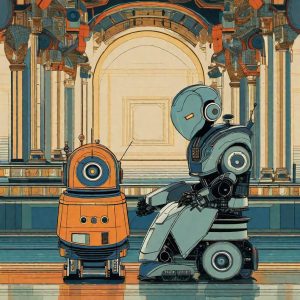
The dictionary of words of foreign origin states that “…a robot – 1. an automatic device with anthropomorphic action that partially or completely replaces a person when performing work in life-threatening conditions or inaccessible objects. 2. A special program for automating routine tasks. 3. A humanoid toy that can imitate the movements of a living being.”
There are different criteria for classifying robots. Let’s look at some of them.
Table 1
| Name of the criterion | Types of robots |
| By application environment | Polar – designed for exploring ice massifs and moving through areas with uneven terrain. Aerial – UAVs or drones. Ground vehicles – unmanned vehicles designed to move on the ground. Underwater – studying the underwater environment, autonomous underwater vehicles. Delivery robots, whose main task is to move objects in space. |
| By size | ● Macro work. ● Micro-robots (often compared to existing microorganisms); ● Nanorobots (devices of molecular and atomic size). |
| By control method | ● Autonomous (able to act independently without human assistance);  ● Controlled (require commands from the owner to perform the simplest manipulations). |
| By mobility | ● those that can move independently (drones, robotic carts, probes); ● those that are fixed in one position, in one specific place (robotic arms for welding metals). |
| On the timeline | 1st generation ROBOTIC MANIPULATORS This type of robot is controlled by a human, and they, in turn, perform the simplest functions, such as moving objects. 2nd generation EDUCATIONAL WORKS They can observe, memorize, process, and reproduce information. Training methods for these mechanisms are divided into 4 groups depending on the internal programming: imitation, reinforcement learning, deep learning, and decision tree. 3rd generation ROBOTS WITH TOUCH CONTROL These robots receive all the necessary information from their sensors, and an internal controller or computer indicates what actions they should take depending on the information received. They can reprogram themselves to adapt to new environmental conditions. 4th generation INTELLIGENT ROBOTS They have more sophisticated sensors and internal programming, and are in continuous communication between the robot and its controller, which makes the decision-making process much faster and more accurate. |
So, robots are all around us. When solving the problem of creating robots, one of the natural ways is to copy humans and wildlife in general. However, the search for fundamentally new ways, determined by the capabilities of modern technology, is no less important. Automation has touched so many areas of our lives, because if you can transfer part of the routine to a robot assistant who never gets tired, why not take advantage of this opportunity?
Натисніть, щоб оцінити цю публікацію!


